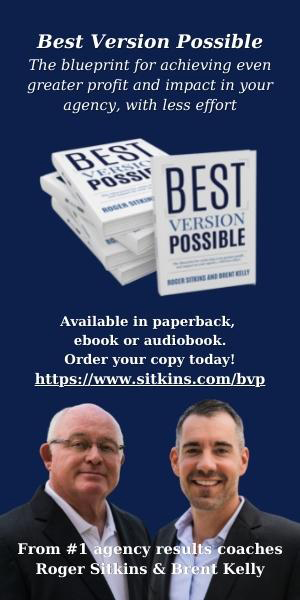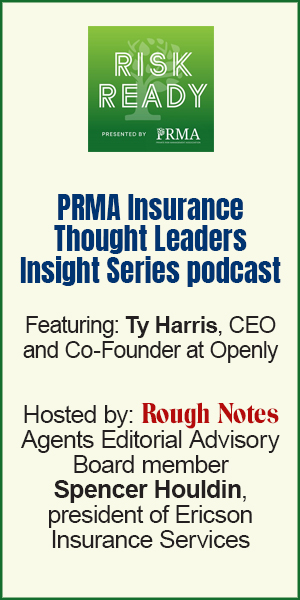A four-year look back at the sustainability
of remote work in the insurance industry
[O]ur experiences over the past four years prove that
work in the insurance industry is more flexible than we thought it could be … .
By Dustyne Bryant, CIC, CISR
It’s 2019 in the insurance industry. You wake up, grab coffee, throw on your last clean business-casual outfit, and rush out the door. Your office is less than 10 miles away but you leave 60 minutes early because the warm sunshine guarantees slowdowns and at least three accidents on your route.
You arrive at your desk—either an interior cubicle or a coveted office—and are greeted by the hum of printers, the dialing fax machine, and a whiff of Kevin’s two-day-old tuna lingering in the trash. Lunch rolls around, but you’re already behind because you’ve taken ten phone calls, Jim needed printer help and Melissa from ABC Insurance dropped in unannounced. By 5:00 p.m., you debate staying late for some quiet productivity or pushing today’s tasks to tomorrow, realizing you’re stuck in your own “Groundhog Day” cycle.
Flash forward to 2024. The pandemic forced a shift to remote work, proving most tasks could be done outside the office—yours included. You’ve enjoyed remote work. You’ve hit your stride: You are more productive with fewer distractions, and the two hours saved from commuting go to morning yoga or starting dinner. Laundry runs while you tackle spreadsheets, customer files are emailed instead of faxed, and industry partner “pop-ins” are replaced by scheduled virtual meetings. You’ve discovered you can “boss” a full day’s work from home in just six hours.
A 2020 study on remote work by McKinsey reported a significant increase in productivity among remote insurance workers, particularly in roles like underwriting and claims management. However, challenges like maintaining company culture and ensuring employee well-being began to surface, setting the stage for a hybrid model that many companies favored post-pandemic.
A new year has arrived and there are more and more reports and debates about return-to-office (RTO) policies, particularly within industries like insurance.
The RTO push
In 2024, companies began challenging the productivity claims of remote work. Amazon, Citigroup, JPMorgan Chase, and others have reintroduced five-day-in-office RTO mandates, arguing that in-person collaboration fosters innovation and efficiency. However, recent surveys suggest a very different reality. The 2024 Flex Report by Scoop revealed that only a third of Fortune 500 executives believe RTO mandates directly improve productivity. For insurance firms, the complexity of RTO decisions is heightened by the industry’s reliance on talent retention.
The insurance industry is aging, a tale that has been told 1,000 times. Fewer and fewer professionals have extensive experience working in an office setting. For example:
- Insurance professionals with one to three years of experience have likely only known work from home (WFH) or hybrid work models. In addition, much of their secondary school and/or college experience was conducted remotely because of the pandemic.
- Insurance professionals with four to eight years of experience barely experienced a full work-from-office (WFO) environment before the pandemic thrust them into WFH models.
- Insurance professionals with nine to 15-plus years of experience have experience on both sides of the WFO and WFH equation. This class of insurance professionals knows how much time commute and distractions took from their personal and professional lives and have actualized the benefits of remote work.
But let’s look at emerging professionals, persons aged 18 to 21 years old (maybe even 16 or 17):
- Graduating students, some of whom are virtual, conduct their schoolwork on computers, utilize online textbooks, and interact through classroom chat groups. On-campus college students attend class two to three days a week with maybe a total of four to six hours on those days. In between, they are completing work at home, hanging out with friends, interacting with peer groups, competing in sports, or working internships or odd jobs.
- If the emerging professional isn’t a college student, they are likely working low-level jobs building skills until they find what they believe will be their “career” path; remember, we’re focused on a career in risk management and insurance. These individuals have likely watched their parents work from home and become more involved in their children’s lives because of the flexibility that remote work provides. They see what a “career” can look like. What their parents have is what they want.
Ask yourself at this point, if any of these sets of professionals will be easily persuaded that a full RTO policy is going to impact them positively. In an era where employers offer similar compensation packages and health benefits, what will attract emerging professionals? I dare say the time to issue RTO policies, at least within the insurance industry, has probably come and gone.
Sustainability of WFH in the insurance industry
Given that the insurance industry is in growth mode for utilizing advanced digital tools to enable remote workflows, WFH or WFA (work-from-anywhere) options are more sustainable than ever before. The need for harboring a server room stacked ceiling high with data servers and running backups overnight is fading year by year. Insurance companies and agencies more frequently utilize cloud-based agency management systems, SaaS (software as a service) programs, automated underwriting, and AI/chatbot-supported customer service to drive remote operations.
While client-facing roles in insurance sometimes benefit from in-person engagement, the pandemic demonstrated that virtual consultations can be equally effective. Tools like video conferencing and virtual policy reviews have become standard, suggesting that client satisfaction does not necessarily hinge on physical presence.
Let’s not forget a greater benefit to companies. With a well-managed remote workforce, the world is their oyster. Okay, that may be a little too expansive, but companies with remote work policies have a greater ability to expand talent searches outside of their immediate areas and attract talent that possesses the skills the company needs. The result may look like a team with greater diversity in skill, experience, and perspective.
Challenges of remote work
Despite its advantages, remote work presents several hurdles for the insurance industry. To name a few:
- Regulatory compliance may be a little trickier in remote settings.
- Maintaining an engaged company culture and fostering growth opportunities can be challenging without physical interactions.
- Measuring productivity and accountability remains a concern, especially for roles that traditionally relied on in-office supervision. Programs are available to track clicks, time spent on tasks, keyboard and mouse activity, idle time, screen captures, email activity, and more. While a majority of supervisors “think” that productivity software improves performance, an overwhelming majority of employees believe it diminishes performance and morale.
I recently came across a forum where someone expressed frustration over their spouse’s hybrid work ethic compared to their own in-person routine. They described their spouse of 20 years as a provider, patient, engaged, and thoughtful but resented their flexible schedule—working only four to six hours a day, prioritizing family needs, hobbies, or exercise. They couldn’t understand why an employer would retain someone they saw as “lazy” and even said they’d fire their spouse if they were their employee.
The responses that followed from readers were indicative of the post-pandemic shift in the workforce. Many responses praised the spouse for finding work-life balance, urging the writer to rethink their own work-life priorities. Some highlighted how certain position tasks (like insurance sales and servicing) can be performed anywhere.
Out of 300-plus responses, none suggested confronting the spouse about being “lazy,” improving their work ethic, or being fearful that the spouse may lose their job for having such work habits.
Strategies for the years ahead
Are we working to live or living to work?
When focusing on prioritizing enjoying this experience called “life,” time is one non-renewable resource. The COVID-19 pandemic gave us all something that had previously only been experienced on an individual basis, a shift in priorities. Generally speaking, personal shifts in priorities usually follow an impactful event (like a near-death experience). Like a near-death experience, the pandemic brought heightened awareness of mortality and the preciousness of time, but at a nearly global scale. Once barriers were broken on positions that truly could work from home successfully, people found a way to work and live, not live to work.
Insurance leaders are increasingly recognizing that performance should be measured by deliverables rather than physical presence. This shift aligns with broader workforce trends emphasizing output and value creation. Before considering RTO policies that could negatively impact workplace culture, consider the following approaches:
- Establish Key Performance Indicators (KPIs). These should have specific metrics tied to job roles or functions and should be both measurable (quantitative deliverables) and qualitative (feedback).
- Define deliverables as “SMART.” These statements should be “designed in a way to foster clear and mutual understanding of what constitutes expected levels of performance and successful professional development,” according to a “how-to” guide on SMART goals, a concept created by consultant George T. Doran. SMART is an acronym for:
- Specific
- Measurable
- Achievable
- Relevant
- Time Bound
- Document process and deliverables. Documented processes ensure that deliverables and outputs are consistent between team members. In addition, documented processes enable seamless reassignment of tasks between team members as well as efficient training and onboarding of new team members.

- Implement task management tools. Utilize agency management systems or project management tools to assign tasks and track progress. Most insurance companies and agencies have some type of AMS or CRM. If not, they should. Contact a representative of the AMS to help find processes that will work for your business.
- Foster communication and feedback. Teams should meet frequently to discuss progress, challenges, and priorities. These meetings should once again focus on outcomes rather than hours worked. Regular check-ins will build connections between individuals and teams. Teams should be encouraged to provide feedback that improves processes and allows growth when mistakes are made.
- Reimage a remote-friendly culture. Google “Remote team- building activities” and see what happens. With the boom of WFH and WFA, new services (like withconfetti.com) have popped up that help companies engage with their remote teammates. If that’s out of budget, try one of these:
- A weekly book club
- Virtual lunches; send a $25 gift card to team members
- Virtual co-working (no words needed, or casually chit-chat while working on tasks)
- Take online classes together and schedule study sessions
- Send out craft kits and create a virtual crafting session
As RTO mandates resurface, swirl around forums, and create concern, sustaining remote work requires continuous investment in more than just technology. By embracing flexibility, leveraging technology, and aligning policies with employee preferences, insurance companies and agencies can thrive in this evolving landscape.
One thing is for sure, our experiences over the past four years prove that work in the insurance industry is more flexible than we thought it could be, and the sustainability of work-from-home or work-from-anywhere policies depends on thoughtful, strategic implementation. n
The author
Dustyne Bryant, MBA, CIC, CISR, is the Director of Risk & Insurance Education and Research, Personal Lines Academic Director, and host of the Awkward Insurance Podcast for the Risk & Insurance Education Alliance. Dustyne is licensed in P&C and L&H in Arkansas and P&C in Texas. Dedicated to Personal Lines Insurance since 2007, she has a demonstrated strength in technical comprehension cultivated through working with a vast selection of regional, national, and surplus lines carriers as a licensed agent, account manager, and department leader. She graduated from the University of Arkansas at Little Rock, obtaining her MBA (2015), B.S. cum laude, Criminal Justice (2011), A.A., Law Enforcement (2010), and Conflict Mediation Graduate Certificate (2015). She earned her CISR designation in 2011 and CIC designation in 2012.In her role, Dustyne collaborates with other experts to deliver relevant and well-researched practical educational content to growing risk and insurance professionals.





